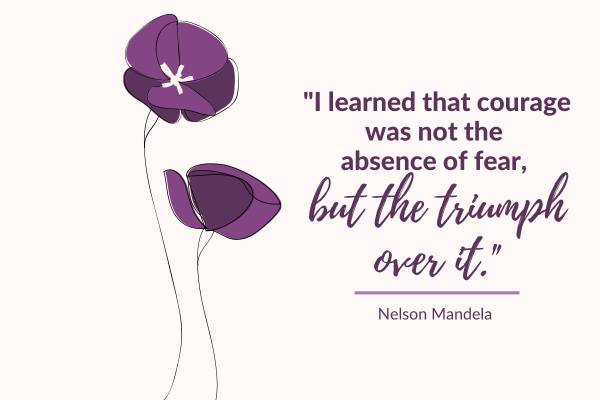It’s the peace and quiet of youngsters lastly sleeping. But mid-way by your exhaled sigh of reduction, you hear a tiny voice chirping. “Mom! Dad! I’m scared!”
It’s nothing new–through the years, you’ve checked for monsters beneath the mattress, velociraptors within the closet, aliens outdoors the window, and an enormous, creepy clown that supposedly visits your youngster’s room at evening.
Even your finest detective expertise have by no means turned up something greater than a few mud bunnies and a lacking sock.
Still, your kiddo stays uncertain.
Because…what if?
Common childhood fears aren’t restricted to nighttime, after all–many kids are afraid of every little thing from swimming swimming pools (what if there’s a shark within the deep finish?!?) to thunderstorms (what if the lightning will get me?!?) to spiders (are you able to blame them?).
Some fears could also be extra respectable than others, however all are very actual to your youngster, whether or not they’re two or twelve.
If there’s a fierce imaginary one thing plaguing your own home, don’t fear: your kids don’t have to develop up unreasonably afraid of the darkish, or the rest!
(Looking for tactics to encourage your kids? Our FREE record of 27 Encouraging Words and Phrases is filled with useful ideas.)
The 5 methods under will assist give your youngster the boldness and braveness to courageous the bogeymen–alongside life’s weightiest, most sensible fears.
1. Validate, Rather Than Brush Off, Your Child’s Feelings
You might really feel too busy, annoyed, or exhausted to discuss zombies, vampires, or any of the frequent antagonists of macabre fiction once more. (“They’re just made-up creatures, Honey!”)
But youthful kids, particularly, are nonetheless making sense of the world and sorting actuality from fantasy. That distinction is understandably murky.
It’s our job to reassure our kiddos that sure threats are far much less believable than others (or simply plain not possible), however we will accompany that assurance with a pang of empathy, too. It’s arduous to be little and awash with lots of or extra pictures–and verbal warnings–of potential risks every day.
Kids aren’t foolish for resorting to struggle and flight whereas processing every little thing; concern first, in-depth reasoning later. (Even although you know your child gained’t get meals poisoning from that chunk of broccoli, he’s not so certain…)
And, after all, concern might be helpful. Its function in survival is crystal clear.
Rather than dismissing our youngsters’s anxieties, it helps to reply with empathy and encouragement.
Lending a sympathetic tone doesn’t imply enjoying into the nervousness or the concern. It simply means we’re letting our kids know we perceive the way it feels to be scared–and it’s nothing to be ashamed of.
2. Prompt Your Kids to Problem-Solve Solutions With Confidence
After exhibiting sympathy, it’s time to specific that we’re assured our kids can overcome their fears.
Neuroscientists and psychologists agree that while some fear is inherent, much of it is also learned.
The improbable information is that this permits us extra management over our fears. And we will all agree that having extra management is an advantageous place to be.
In reality, kids who’ve a bit extra management over their lives–whether or not it’s making just a few age-appropriate choices all through the day or being given an opportunity to voice their opinions–really feel elevated ranges of belonging and significance. This naturally raises their emotions of validation and confidence.
And, as you possibly can think about, assured kids are extra keen to take wholesome dangers and work bravely by their fears.
Let’s say your 6-year-old approaches you–having been uncovered to one thing his previous sister was watching–and needs you to consolation him. He depends on you to handle his concern and defend him.
This is pure, after all. We are the parents, and we defend our youngsters! But it’s by no means too quickly to introduce our kids to instruments that can assist them problem-solve fearful conditions for themselves.
(*5*)
You can kneel down to your 6-year-old and say, “When you see something on the TV that bothers you, you change the channel or walk away!” Or, “You can remind yourself that those are actors, and they are just pretending!”
Of course, not all fears are primarily based on one thing pretend. One day, your 11-year-old would possibly point out a bullying incident at college. She’s afraid to return to that very same class and be humiliated–and even bodily assaulted.
First off–it’s wonderful that she’s going to you for defense. It means she trusts you and your steering. You’ll provide it gladly, after all, and help in any method you possibly can. (You all the time need to maintain these strains of communication open!)
But conditions like these are additionally a beautiful alternative to coach our kids on problem-solving–like how to deal with conflicts with different people.
With bullying, options would possibly embody ignoring taunts, speaking to college directors, studying self-defense, involving counselors, and even going to the police. You can current a number of choices and prepare your kids on the most effective plan of action for the circumstance.
Because subsequent time, you will not be out there or close by to assist.
Any time we emphasize problem-solving, we’re giving our youngsters an opportunity not to sidestep concern and its destructive results, however face and work by it.

3. Slow-Roll Exposure to Scarier Shows
We can’t management every little thing our youngsters are uncovered to. Even kid-friendly motion pictures have a token unhealthy man. It’s a part of life.
But we can handle a lot of the knowledge that comes by their screens. This consists of putting in smartphone, tv, and pill controls.
And, for what we will’t monitor, we will present context and important pondering.
Remember–every little thing our youngsters watch on tv or the Internet might be duly processed of their information-mining minds.
While watching one thing scary, we will put issues in perspective. It may very well be: “those soldiers died for a good cause,” or, “this has been exaggerated to make the story more dramatic” (and for the littlest tykes, “Ursula can’t actually steal Ariel’s voice and turn King Triton into a sea polyp– that’s silly!”).
If kids are watching one thing scary primarily based on a real story–let’s say a battle film–we will discuss how the real-life characters confirmed avarice, bravery, and every little thing in between. It’s a golden alternative to discuss morals and your loved ones’s perception system–each of which supply a foundational stronghold for going through fears.
The final intent isn’t to maintain our youngsters unaware of all real-life ills: it’s to slowly expose them to potential hurt. This may also help them put the items of a typically tragic world into place with out extreme fear and tremendous sleepless nights.
While we might frantically yell at them to keep out of the road or keep removed from a cliff’s edge, nothing sudden and/or traumatic has to be seen on display for them to come to phrases with arduous realities.
And, though conquering concern is nice–like Bruce Wayne embodying Batman to overcome his concern of bats–eliminating it doesn’t have to be the last word aim. Slightly concern saved in examine might be helpful when it comes to procrastinating over an examination, driving rigorously within the snow, and speaking to strangers, amongst different issues.
We simply don’t need concern to be debilitating: particularly in a world the place kids are reporting increased anxiety over every little thing from check scores to aggressive try-outs. The intention is to assist our kids discover a wholesome stability.
4. Increase Quality-Time Comforts
Children that really feel protected and safe–each in physique and in thoughts–are seemingly to courageous their fears with larger ease.
In our on-line Positive Parenting Solutions® course, we argue that the finest method to give kids this deep-seated consolation is thru MIND, BODY AND SOUL TIME® actions (MBST).
When kids are leery of bedtime and obsess over fears at evening, night MBST can provide them a way of being “armed”–protectively–with love. They might go to sleep with much less battle and sleep way more peacefully.
Whether their apprehension about bedtime stems from separation nervousness, evening terrors, or an oh-so-common concern of the darkish, including MBST into bedtime routines distracts kids from scarier “what if” pondering. Not solely does it present an incredible sense of consolation, however it additionally boosts well-being and confidence.
All you want for a profitable MBST session is 10-Quarter-hour of your undistracted time. Your youngster will get to select the exercise, and you then simply want to label it–each earlier than and after the actual fact.
“I’m so happy to start our ‘mommy/daughter’ time. It’s my favorite time of day.” And, “I really enjoyed our ‘daddy/dude’ session this evening!”
Giving MBST a particular title helps hone in on the truth that you’re dedicating this undivided time to your kids. Your kids will perceive your dedication and really feel all of the extra grateful.
The solely distinction between daytime and bedtime MBST actions is that night MBST is ideally calm and relaxed. This would possibly imply you learn aloud collectively, discuss to each other about your day, play 20 questions, and even construct a comfortable pillow fort atop their mattress. You simply don’t need your kiddo getting too amped up earlier than sleep.
Even in the event you don’t have time for MBST each night, eliminating nervousness, combating, and energy struggles as a lot as potential earlier than bedtime helps kids go to sleep quicker.
And, the subsequent day? Well-rested kids are higher outfitted, each emotionally and bodily, to face fears head-on.
5. Differentiate Between Real and Exaggerated Fears
Sometimes, kids hyperbolize their fears to get our consideration. Delayed bedtime ways like, “Can you check my closet for monsters again,” or a request like, “Can I sleep next to you tonight, just this once?” may very well be basic examples.
This is particularly seemingly if kids are feeling unnoticed or aren’t getting that day by day dose of MIND, BODY AND SOUL TIME® bonding.
You know your youngster finest. You can most likely inform if the concern is contrived or in earnest. If not, there are specific signs to look out for.
If your loved ones has not too long ago confronted trauma, or your kids really feel constantly or uncontrollably upset, afraid, or anxious, you might have considered trying to search assist. The concern may very well be situational (and nonetheless in want of consideration) or may sign an underlying anxiety disorder or phobia.
Plenty of counselors and psychologists concentrate on treating concern in kids, so if doubtful, don’t hesitate to attain out for assist.
Final Thoughts
Fear could also be an unlucky actuality, however in our youngsters’s day by day lives, it ought to by no means be paralyzing. With these methods, you possibly can assist your kids tame their deepest issues and develop more and more confident of their inside power.
From toddlers to teenagers, our kids are warriors. Let’s assist them see that.
What You Should Do Next:
1. Subscribe to my Newsletter:
Sign up for my publication for parenting suggestions to make it easier to create a happier house and change into the father or mother you all the time wished to be. Plus, whenever you subscribe, I’ll additionally ship you a duplicate of our strategy-packed information 10 Tips for Better Behavior – Starting NOW!
2. Register for my FREE 60-Minute Class:
Register for my free class referred to as How to Get Kids to Listen, Without Nagging, Yelling or Losing Control. Classes run a number of instances per week however I like to recommend you register early, as areas are restricted.
3. Enroll in my 7-Step Parenting Success System® Course
Enroll now in my confirmed 7-step system for busy parents prepared for change (it is rated 5 stars on Google). Plus, for a restricted time, save 10% plus get a FREE improve on all plans—utterly risk-free and with lifetime entry.
About the Author




